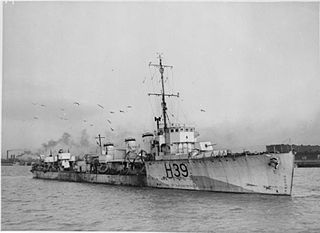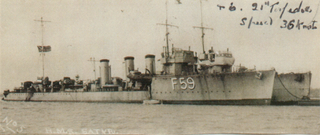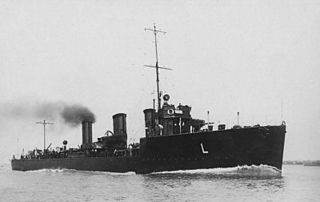
HMS Skate was an R-class destroyer of the Royal Navy that was laid down and completed during the First World War. She was built at John Brown Shipyard at Clydebank in Scotland and launched on 11 January 1917.
HMS Starfish was an R-class destroyer which served with the Royal Navy. She was launched on 27 September 1916 and sold to be broken up on 21 April 1928. She was built by Hawthorn Leslie of Hebburn Tyne.
HMS Torrent was a Royal Navy R-class destroyer constructed and then operational in the First World War. She was sunk, with most of her crew in 1917.
HMS Tornado was a Royal Navy R-class destroyer constructed and then operational in the First World War. She was sunk, with most of her crew in 1917.

HMS Taurus was an R-class destroyer which served with the Royal Navy during World War I. Ordered from Thornycroft in 1915 and launched in 1917, the vessel operated as part of the Harwich Force until the end of hostilities. Shortly after entering service, Taurus formed part of the destroyer shield for the Royal Navy's bombardment of Ostend that successfully sank the German destroyer S20. After the War, the destroyer was reduced to reserve and scrapped in 1930.

HMS Teazer was an R-class destroyer which served with the Royal Navy during World War I. The destroyer was launched in April 1917 and, on trial, proved to be one of the fastest afloat, exceeding 40 knots. Attached to the Harwich Force, the ship had an uneventful wartime career. After the war, Teazer was kept in reserve until being sold to be broken up in 1931 following the signing of the London Naval Treaty that limited total destroyer tonnage.
HMS Recruit was a R-class destroyer built for the Royal Navy during the First World War. She was sunk by a German U-boat four months after she was commissioned in April 1917.

HMS Retriever was a Thornycroft-built R-class destroyer which served with the Royal Navy during the First World War. Launched on 15 January 1917, the vessel formed part of the Harwich Force and took part in operations off the coast of Ostend in support of the bombardment of the town in June that year. During August the following year, the vessel attempted to deploy a seaplane from a towed lighter, but a lack of wind meant the operation was unsuccessful. The vessel was also jointly credited with the destruction of the submarine SM UB-54 that year, although this has been disputed. After the war, the ship was placed in reserve and was sold to be broken up on 26 July 1927.

HMS Satyr was an R-class destroyer which served with the Royal Navy during the First World War. Launched on 27 December 1916, Satyr joined the Harwich Force under the command of Commander Hubert de Burgh. In 1917, the destroyer formed part of a force protecting the monitors Erebus and Terror in their bombardment of Ostend. As part of this action, Satyr, along with sister ships Taurus, Sharpshooter and Torrent, sank the German destroyer S20. After the war, the ship served with the Torpedo School at the Devonport. In 1923, the Navy decided to retire many of the older destroyers in preparation for the introduction of newer and larger vessels and Satyr was sold to be broken up on 16 December 1926.

HMS Thisbe was an R-class destroyer which served with the Royal Navy. The ship served as part of the Harwich Force during World War I. She was launched on 8 March 1917 and sold to be broken up on 31 August 1936.

HMS Tristram was a modified Admiralty R-class destroyer which served with the Royal Navy. She was operational for less than four years between being commissioned on 30 June 1917 and being sold for breaking up on 9 May 1921.

HMS Ulster was a modified Admiralty R-class destroyer which served with the Royal Navy.

HMS Thruster was an R-class destroyer which served with the Royal Navy. She was launched on 10 January 1917 and scrapped on 16 March 1937.

HMS Undine was a modified Admiralty R-class destroyer which served with the Royal Navy.

HMS Urchin was a modified Admiralty R-class destroyer which served with the Royal Navy. It was the third ship in the Navy to be named after the sea urchin and the first in the class to be built by Palmers in Jarrow. It was launched in 1917 and served with the Grand Fleet during World War I, seeing action in the Second Battle of Heligoland Bight.

HMS Ursula was a modified Admiralty R-class destroyer which served with the Royal Navy. The vessel was launched in 1917 at Greenock in Scotland and served with the Grand Fleet during World War I.

HMS Sharpshooter was an R-class destroyer which served with the Royal Navy during World War I. Launched on 27 February 1917, the ship joined the Harwich Force, undertaking convoy escort duties. The vessel also took part in the Navy’s bombardment of Ostend later that year. On 1 June 1918, the destroyer rescued Captain A. C. Sharwood, one of the first pilots of the Royal Australian Navy, who ditched his Sopwith 2F.1 Camel nearby. After the war, Sharpshooter joined the Navy gunnery training establishment at Plymouth, but did not stay long and was reduced to Reduced Complement on 5 March 1919. The Royal Navy was rationalising its destroyer force and Sharpshooter, deemed superfluous, was sold to be broken up on 29 April 1927.

HMS Simoom was an R-class destroyer which served with the Royal Navy during World War I. Launched on 30 October 1916, the vessel operated as part of the Harwich Force until torpedoed by the German destroyer S50 on 23 January 1917. The ship's magazine exploded and 47 lives were lost. The name was reused by the first S-class destroyer, Simoom, launched on 26 January 1918.

HMS Redoubt was an R-class destroyer which served with the Royal Navy during World War I. The R class was an improvement of the preceding M-class, primarily through having geared steam turbines which offered greater efficiency and range. Launched on 28 October 1916, the ship joined the Harwich Force, operating as part of a destroyer flotilla undertaking convoy escort and anti-submarine operations in the North Sea. During 1918, Redoubt took part in an experiment to launch fighter aircraft from a lighter towed beyond a destroyer. The first flight took place on 1 August and the first successful operation ten days later when the Sopwith Camel flew by Lieutenant S.D. Culley took off and destroyed the German airship LZ 100. After the war, the vessel was transferred to the Home Fleet but was sold on 13 July 1926 to be broken up, part of a large scale disposal of older destroyers by the Navy.

HMS Lochinvar was a repeat Laforey-class destroyer which served with the Royal Navy during the First World War. Named after the character in the poem Marmion, the ship was originally to be called HMS Malice but was renamed prior to being launched on 9 October 1915. The destroyer joined the Harwich Force and took part in anti-submarine patrols, as well as escorting the monitors Erebus and Terror for their attacks on the canal gates at Zeebrugge and the port of Ostend in 1917. After the Armistice, the vessel was placed in reserve and sold to be broken up on 25 November 1921.










